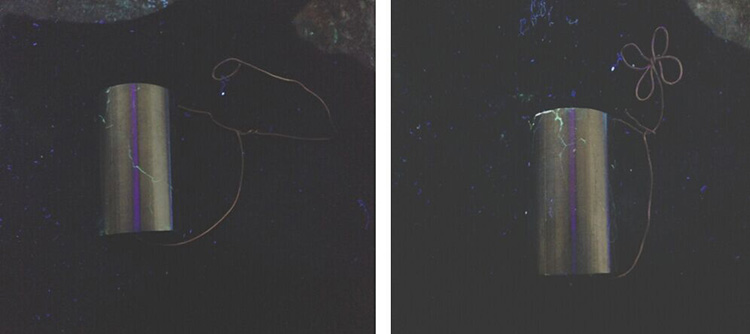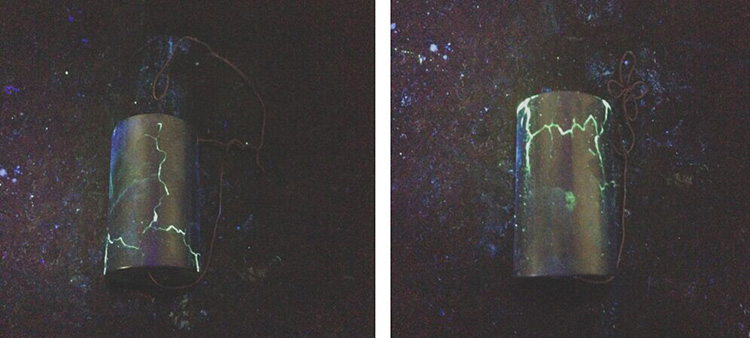1. Casting Characteristics And Inspection Difficulties Of Parts
Nickel-copper alloy has good room temperature mechanical properties and high temperature strength, high corrosion resistance, easy processing, good wear resistance, and is widely used in parts with wear resistance requirements. However, nickel-copper alloy is a new type of material, and the casting process is not very mature. In addition, due to the high copper content, the casting difficulty is very large, and intergranular crack defects are easily generated.
Nickel-copper alloys are not magnetic, and the method of detecting intergranular cracks can only select permeation detection. However, such intergranular cracks are generally difficult to detect when infiltrated, and are easily missed.
Penetrant testing is a non-destructive testing method for detecting surface opening defects based on the principle of capillary action. When using this method, the defect must be opened, so the surface condition of the part to be inspected is very strict. Any dirt left on the surface of the part, such as oil, dust, metalworking debris and scale, affects the results of the penetration test. If the defect surface opening is blocked, the penetration detection will be defective. This is the case for the leak detection of nickel-copper alloy castings.
Chou Meigan of Yancheng Nuoxin Electronic Equipment Co., Ltd started from the principle of penetrant testing and pretreatment, pre-treated with special corrosion cleaning solution before permeation detection, and selected a reasonable penetrant testing opportunity to fully expose the surface defects of nickel-copper alloy castings, also provides the required surface condition for penetrant testing to ensure the quality of the penetration test.
2. Process Analysis
Nickel-copper alloy castings are arranged with two penetrant testing procedures during processing. The test is carried out by using a water-washing medium-sensitivity fluorescent penetrant. The specific parameters are: applying penetrant by dipping method, penetrant grade ZL-60D, permeation time 30 minutes (in which the permeation time is 13 minutes, dripping time is 17 minutes), drying temperature 68 ° C, drying time 10 minutes; imaging agent grade ZP-4B, dry powder spray imaging, imaging time 20 minutes. The specific testing or inspection process is as follows:
- 2.1 The process of infiltrating the blank bar is arranged as follows: casting→heat treatment→X-ray detection→penetrant testing. Since surface defects are likely to occur after casting and heat treatment, it is reasonable to arrange the penetrant test after casting and heat treatment. At this time, the pre-cleaning method of the penetrant test is alkali cleaning, and defects such as cracks are rarely found after the penetration test. X-rays can often see a lot of grain coarseness, but this is not the scope of X-ray detection, and is generally not used as a basis for rejection.
- 2.2 After all the processing is completed, 100% penetration inspection is performed on all surfaces of the finished parts. At this time, the pre-cleaning method of the penetration inspection is alkali cleaning, and some crack defects can also be found at this stage.
- 2.3 The parts that have passed the inspection and passed the inspection shall be tested for summary. At this time, some crack defects can be found with a magnifying glass. These defects were not detected during penetrant testing.
- 2.4 For the analysis of such crack defects, metallographic low-spectrum inspection analysis. Through comparative analysis, the reasons for such crack defects are not found in penetrant testing:
- 2.4.1 These cracks are mostly along the crystal cracks, very fine; if they are not corroded, they can not be found by ordinary visual observation.
- 2.4.2 There are also some cracks which are generated during the processing. The openings of these crack defects are blocked by dirt such as metal debris during processing, and the penetrant test cannot be found.
From the above analysis, it can be seen that if the special pre-cleaning method is not used for the treatment, the cracks along the crystal crack and the crack in the opening are difficult to be completely inspected.
3. The Effect Of Pre-Cleaning On Penetrant Testing
Pre-cleaning is the first process of penetrant testing and the most important process, because the physical basis of penetration testing is capillary action. The presence of grease and dirt on the surface may prevent the occurrence of capillary action, with the following effects:
- 3.1 Prevent the penetrant from penetrating into the surface opening defects and even blocking the defects.
- 3.2 Even if the penetrant penetrates into the defect, it will mix with the oil in the defect, causing the displayed fluorescent brightness or color intensity to decrease.
- 3.3 The oil remaining on the parts is easy to cover up the defects of these parts.
Therefore, before the penetrant test, the part must be pretreated with a suitable chemical cleaning solution to clean all the dirt in the surface opening (including fine opening) defects to ensure the penetrant testing effect.
4. Process Improvement Test
It can be proved by experiments that the corrosion of the cleaning corrosive liquid can fully expose the crystal cracks on the surface of the nickel-copper alloy casting, and the metal debris in the defect can be treated to ensure the reliability of the penetrant testing.
4.1 Penetrant testing before improvement
The parts to be inspected are infiltrated after the blank stage and final machining. The pretreatment uses a weakly alkaline cleaner (ARDROX6333: volume ratio of water to 1:3 to 1:4), and the parts are inspected before the penetration test. Pre-cleaned and then tested with a water-washed, medium-sensitivity fluorescent penetrant.
In the penetration test of the blank stage, no defects such as surface cracks were found.
After the final machining, a further penetration test was carried out and it was found that there were cracks in individual parts; however, under the magnification of 10 times, 50% to 60% of the parts were cracked. Seriously affected the production schedule and the delivery of the entire task.
To this end, the cleaning agent and permeation detection method used in the pretreatment method of nickel-copper alloy castings were sorted and analyzed, and a large number of tests were carried out to obtain a practical permeation detection method for nickel-copper alloy castings.
4.2 Comparison test to change the cleaning corrosion solution
Test 1: Test 30 blank parts. The pretreatment is cleaned with a weak alkaline cleaning agent ARDROX6333; ratio: weakly alkaline cleaning agent: water = 1:3 to 4 (volume ratio); then, washed, thoroughly dried, and infiltrated.
Test results: 5 pieces of cracks existed, and the conclusion was unsatisfactory; no obvious cracks were found in the remaining 25 parts, and the conclusion was qualified. The test results are shown in Fig. 1.
Fig.1 Improved pre-penetration test results
Test 2: Test the same 30 blank parts. The pretreatment was etched with a 10% aqueous solution of ferric chloride for 5 minutes; then, washed with water, thoroughly dried in an oven, and subjected to permeation detection in the same manner as in Test 1.
Test results: 20 parts found obvious cracks, the conclusion was unqualified; 10 pieces did not see cracks, the conclusion was qualified.
It can be seen that the use of 10% aqueous solution of ferric chloride as a corrosion cleaning agent to corrode the defect opening of the part can fully expose the surface defects. The test results are shown in Fig. 2.
Fig.2 Penetrant test results after corrosion of ferric chloride aqueous solution
5. Improvement Measures And Effects
Thus, the following improvements are made to the process of nickel-copper alloy castings:
- 5.1 After the wool material enters the factory, firstly perform surface turning processing according to the machining allowance (surface glossiness reaches Ral.6); after the turning process, increase the penetrant testing process (pretreatment using 10% aqueous solution of ferric chloride for corrosion) After the penetration test is passed, X-ray inspection is performed, and then the next machining is performed.
- 5.2 After the mechanical processing is completed, a permeation test is arranged; the pretreatment is carried out by using 10% aqueous solution of ferric chloride to remove defects generated during the processing.
- 5.3 For nickel-copper alloy castings, if the defects are removed by the grinding method, the corrosion must be performed before the penetrant test can be performed.The nickel-copper alloy castings were tested using the improved penetrant testing process, and the reliability was greatly improved to meet the delivery requirements.
6. Conclusion
In the penetrant test of nickel-copper alloy castings, in order to avoid the problem of intergranular crack leakage detection, it is necessary to use a ferric chloride solution for corrosion pretreatment to expose the defects to the surface, thereby ensuring the reliability of the test results.
–Translated from《Nondestructive Testing》, No. 5, 2015








